Thanks for your support! If you make a purchase using our links in this article, we may make a commission. And, as an Amazon Associate, I earn from qualifying purchases. See the full disclosure here.
Solar power is becoming popular within the RV community. It’s clean, portable, and doesn’t come with fuel costs. For those that want to take advantage of this technology, but can’t afford the high cost of installing an internal system, battery-powered generators are an affordable solution. We’ll show you the 5 best portable solar generators for RV life and camping on the market. They are:
- Most Popular: Jackery Portable Explorer 1000
- Best for Small RVs: Goal Zero Yeti 200X
- Easiest Expandable: Nature’s Generator
- Biggest Power Station: Bluetti EB 240
- Overall Favorite: Ecoflow Delta 1300
You’ll discover how solar power works as well as how the benefits of adding a solar generator to your camping experience. We’ll help you determine what size will best fit your camping lifestyle and show you some of the front runners in the market.
5 Best Solar Generators For RV Life and Camping
1. Jackery Portable Explorer 1000
One of the most popular brands of solar generators is from Jackery. Jackery has been a trusted name in the solar generator industry ever since it launched its first model in 2015. Their latest edition is the Explorer 1000.
It has a 1,000 watt-hour capacity on a single charge and offers the most output ports compared to all other generators. The LED display panel shows you the power level, how much energy is coming in, and how much is being used. And it’s backlit to make it easy to read.
This 22 pounds generator has a pure sine wave inverter and surge protector built-in. For emergency situations, there’s even an LED flashlight near the handle. On the front panel, it’s separated into different sections to easily understand the input and output areas.
The generator comes with an AC cord that plugs into any 110v outlet. It also comes with a vehicle power port cord, so you can charge while you’re traveling. The Anderson red and black port is where you plug in the solar panels.
To conserve energy, each of their outlet sections has an on/off switch. You can use the three 110v AC power outlets simultaneously without blowing a fuse. It also comes with two USB-A and two USB-C charging ports that will fit most cords. There are two DC circular outlets for your power needs. The bigger of the two fit vehicle charging ports.
Examples of its longevity include: charging a laptop over 12 times, running a TV for 14 hours, and using your electric grill for almost an hour. It also has a quick charge feature to power up your mobile devices.
Recharge times from the AC electric cord or 12v vehicle port average around 7 hours. Using two of their 100W SolarSaga solar panels in ideal conditions will take about 8 hours. One panel they state can take around 17 hours.
Main Specs for the Jackery Portable Explorer 1000
- Weight: 22.04 pounds
- Dimensions (L x W x H): 13.11 x 9.17 x 11.14 inches
- Battery Type: Lithium-Ion
- Watt Capacity: 1,000 W
- Surge Capacity: 2,000 W
- Total Watt-Hours: 1,002 Wh
- Warranty: 24-month warranty
2. Goal Zero Yeti 200X Portable Power Station
Goal Zero designed the Yeti 200X to be ultra-portable for backpackers, those who enjoy the #TentLife, and it’s one of the best solar generators for teardrop campers. Its size and weight are ideal for bags or small storage spaces. It has a quicker than average recharge cycle and can power all of your small electronics.
You won’t have a problem keeping your mobile devices charged up with the dual USB-A and dual USB-C inputs. The 110v AC port will make sure even in the most basic conditions, you can still get that morning cup of coffee. The two DC ports are great for using the air mattress pump or other accessories you need.
The rear fan is quiet, so it won’t “harsh your zen” as you enjoy the peaceful sounds of nature. If you get rained out of your outdoor adventure, it’s safe to bring inside your teardrop to power interior lights for a bit.
This generator isn’t designed to run things for a long time. Some people weren’t satisfied with the shortness of power when they were running their laptops. It’s mainly designed to charge mobile devices, laptop batteries, and run low-level electronics like LED lights.
Those who have used this solar generator for its intended purpose have been very happy with its performance. The Goal Zero Boulder or Nomad solar panels that are sold separately are easy to install and work well. Ideally, a 100W panel can charge the Yeti 200X in 8 hours or less. Plugging it into 110v AC or a vehicle power port can charge it up as little as 4 hours.
Main Specs for the Goal Zero Yeti 200X
- Weight: 5 pounds
- Dimensions (L x W x H): 7.9 x 5.1 x 5.1 inches
- Battery Type: Lithium-Ion
- Watt Capacity: 120 W
- Surge Capacity: 200 W
- Total Watt-Hours: 187 Wh
- Warranty: 24 months for the battery, 1 year for other components, 30-day30 day money-back guarantee if the box is not opened.
3. Nature’s Generator
When you design a solar system in your RV, you can expand it up to the maximum amount of house batteries your battery bay can hold. You can expand your solar intake by increasing the number of panels you have on your roof. Most solar generators limit you to the battery they have inside and the panel that plugs into it.
Nature’s generator is different. Their solar generator units are designed to expand. Each power pod has 720 watt-hours and their panels are 100 watts each. To start with, you can buy either the gold system (the generator and one panel together) or the platinum system (the generator, a power pod, and three panels together).
You can add additional power pods to the generator that extends the electric storage capability significantly. There is no limit to how many additional power pods you can add. Note that power pods are not the same as generators. They don’t have the output ports and other features the main unit has. Each pod adds an additional 720 watt-hours.
The pods take between 8-15 hours to charge with a single 100W solar panel depending on the conditions. When plugged into AC or vehicles directly, they can charge quicker.
For those looking for the best battery powered generator that could supply their whole RV, Nature’s Generator system has the potential. If you want to attempt this, you will need multiple power pods and many panels. Seek professional advice before attempting.
The generator itself holds 720 Wh. It has three 110v AC outlets, one USB-A port, and a DC vehicle outlet. The inputs allow you to charge through 110v AC, solar panels, or Nature Generator’s wind turbines (5 blade, 3 blade, or marine-grade 3 blade).
Nature’s Generator Portability and Convenience
The manufacturer solves the portability issue by installing big wheels on the pods and panels. There’s also an expandable suitcase-style handle on the pods so you can position it where you want it. The digital display shows you the power status of the individual battery, what’s going out, and what’s coming in.
Nature’s Generator also created an app to control the generator for your mobile device. You can run diagnostics, check your levels, power usage, and contact the company. If there’s a problem, the manufacturer can connect with your generator wirelessly and fix the problem on their end.
When you’re not using the generator or the expandable power pods, its a good idea to charge them up every 2-3 months to keep the lead-acid batteries in good working order. Many will transfer the components into their house on the offseason in case of blackouts. The weight of ice and snow is a big cause of downed power lines in the cold months.
Those with sight issues have mentioned problems with the clarity of reading the display panels. They’d prefer it to be bigger and backlit so it’s easier to read. No one’s mentioned anything negative about the user-friendly mobile application. Their customer service has high marks too.
To start off correctly, you need to buy the gold or platinum system first. The power pod is not a generator. It’s an expansion power storage battery only. Nature’s Generator wants you to start with everything you need with their systems first. Their return policies include restocking and shipping fees, so read everything first.
Main Specs for Nature’s Generator Gold System Generator
- Weight: 90 pounds
- Dimensions (L x W x H): 23 x 17 x 22 inches
- Battery Type: Lead Acid
- Watt Capacity: 720 W
- Surge Capacity: 1,800 W
- Total Watt-Hours: 1,800 Wh
- Warranty: 1-year standard warranty, or 2 years for an additional amount
4. Bluetti EB 240
If you’re looking for a solar generator you can actually plug things into and use to cook, run your computer, or keep things going for a longer period of time, Maxoak’s Bluetti (pronounced Blue Eddie) EB 240 may be the way to go. It can run up to 1,000 watts at one time with 2,400 watt-hours in one charge.
The power station has 2 110v outlets, 1 DC vehicle port, a USB-C, and 4 USB-A ports. That may not be a lot compared to others, but when you consider that it can run a 100 watt LCD TV for 24 hours, it’s worth checking out.
Recharge time when plugged into an AC connection can take up to 12 hours. Solar charging can take longer. To ease the charging time, you can use the generator while you are charging. The generator comes with all of the cords and adaptors you need, so you don’t need to worry about extra parts, except the panels.
This is the best solar generator for van life due to its power longevity and convenient size. The unit also has built-in safeguards to prevent overheating, surge protection, and other issues.
Main Specs for the Bluetti EB 240
- Weight: 48.5 pounds
- Dimensions (L x W x H): 19.4 x 6.5 x 14.4 inches
- Battery Type: Lithium-Ion
- Watt Capacity: 1,000 W
- Surge Capacity: 1,200 W
- Total Watt-Hours: 2,400 Wh
- Warranty: 2-year limited warranty on battery and solar panels, 1 year on qualified components, 6 months on non-qualified components once the box is open.
5. Ecoflow Delta 1300
Our favorite generator has to be the Ecoflow Delta Series. This high capacity unit is the best portable solar generator due to its long-lasting charge, multiple ports, and quick recharge time with solar panels.
Ecoflow designs all of its battery generators to recharge from 0 to 80% within the first hour of charging. This can be when it’s charging under optimal conditions. Average charging times are:
- AC input port- 1.6 hours
- Vehicle power port- 10 hours
- Solar panels using 110W (depending on weather conditions):
- 2 panels- 8 to 16 hours
- 3 panels- 5 to 10 hours
- 4 panels – 4- 8 hours
The Delta comes with the most output connections we’ve seen on any solar generator. On the LED display panel side, it comes with 2 USB-C ports and 4 USB-A ports. Two of those USB-A ports are quick-charge capable to decrease recharge time for your mobile devices and laptops.
On the opposite side are six 110v AC ports and a DC vehicle power port. Each section has an on/off switch to conserve power. The display shows you how much power you’re drawing out, taking in, and what the current capacity level is. It also shows you how long until empty you have using the current wattage.
The Delta 1300 has the longevity to run a laptop for 23 hours, a welding machine for an hour and a half, or a 1,000W washer up to 18 hours. Its dual fans are quiet and the rubber feet prevent scratching any surface.
Main Specs for the Ecoflow Delta 1300
- Weight: 30.9 pounds
- Dimensions (L x W x H): 15.7 x 8.3 x 10.6 inches
- Battery Type: Lithium-Ion
- Watt Capacity: 1,800 W
- Surge Capacity: 3,300 W
- Total Watt-Hours: 1,260 Wh
- Warranty: 24-month factory warranty.
RV Solar Generator Buyer’s Guide: What to Consider Before Buying
There are a handful of things to consider before buying a solar generator for your RV. Solar generators come in different sizes and strengths and many have different features and accessories.
Aside from the price, here are a few things to consider when making a purchasing decision for an RV solar generator.
- Power: Solar batteries come in different sizes and can generate and store different amounts of energy. We cover how to determine your own specific power needs in a later section! This is an important step to making sure you get the right size generator.
- Charging Speed: Next, take into consideration how fast the generator can charge or re-charge. Some solar generators need a full day of sun (or more) to fully charge back up to their maximum. If speed is important to you, don’t miss this consideration.
- Weight: Since solar generators are basically a large battery, they can get heavy. If weight is a factor for you, be sure to check the weight of the generators you’re considering.
- Included Accessories: Although some solar power packs come with solar panels included, many don’t! Before buying, make sure you’re aware of what accessories it comes with and what you will need to purchase separately to be able to use it.
How Solar Power Works
If you’re just starting your research into a solar system for your RV, there are a few things you need to know. Understanding the basics of how solar works will help you decide what will work best for you.
Solar panels do not directly feed electricity to your RV or any electrical equipment. The panels themselves absorb ultraviolet radiation from the sun, convert that into electric energy, and send it to a battery. The battery could be your RV’s house battery or the internal battery inside a solar generator.
The batteries used are similar to car or marine grade size. A lithium-ion gel is favored, but there are some manufacturers that still use lead-acid. The batteries can go through hundreds or thousands of recharging cycles without an issue.
The electricity in the battery is DC power (direct current). To convert it to AC (alternating current) power, the electricity must go through a device called an inverter. Newer RVs are starting to come with inverters as either standard or optional equipment, depending on the manufacturer and model type.
For example, if you plug solar panels into the prewired port of your RV, that energy will go directly into your house batteries. Depending on the specifications of your coach, you’ll either have two 6 volt or two 12 volt batteries (your owner’s manual or your RV dealer will be able to give you the specifics).
Two Types of RV Power
Your RV has both an AC and DC electric system. If you turn on your interior lights, the electricity from your house batteries goes directly to the lights, since they run on the DC power of the electrical system.
Your electric outlets inside your RV use AC power. To charge up your cellphone, the house battery electricity will run through the inverter to change the current from DC to AC. From there, it will route the electricity to your USB charging port where your phone charger is connected.
Electrical experts will tell you that the process is more complicated than this, but for our purposes, we want to simplify it for those that are just starting to understand the process. You can learn more by reading our articles in the Related Reading section at the bottom of this article.
Charging Versus Draining
Charging up your house batteries or your solar generator via solar panels can take most of the day. The average charge times are between 8-12 hours. Solar panels range between 100-400 watts. The 100W panels are more common and the most affordable. Ideally, the more wattage you have coming from your panels, the faster the charge.
Every electrical device you use has a wattage-hour (Wh) factor. Wattage-hour is the number of watts a device requires if it were to run continuously for one hour. Without thinking about it, a box fan has a lower Wh than a microwave. Yet a microwave isn’t normally running for an entire hour.
When fully charged, your batteries have a certain amount of Wh stored. This is why you have to be strategic when you turn something electrical on. You can have the solar panels charging the batteries while you’re using them, but they’ll drain faster than they charge.
If you get sucked in on your favorite video game in the morning, the LED TV and game console could drain all of the energy in your generator by lunchtime. When you finally turn everything off, you may not have enough power to use your electric grill or other necessities.
You’ll want to make sure you have a big enough solar system installed to cover all of your electrical needs. Air conditioners require a huge amount of power. Check out our feature article on how to run and RV air conditioner on solar panels if this is part of your solar plan.
How Solar Generators Work
A solar generator is a self-contained device about the size of a desktop computer tower or smaller. Inside the durable case is a single battery. On the front of the case are various outlets to plug both AC and DC electric devices. The best solar generators will have:
- Multiple 110v AC ports that fit both two and three-prong connectors
- Multiple USB-A (bigger) and USB-C (smaller) charging ports
- Circular DC ports of different sizes
- A vehicle power port (also referred to as a “cigarette lighter” outlet found in cars)
- Many solar generators have Anderson plugs to connect solar panels
Solar generators are also known as battery generators. There are three ways to charge them. You can plug them directly into an AC port in your home or campsite shore power station. Most come with a vehicle power plug so they can be charged up while you’re traveling. The last method is connecting them to solar panels, hence the name solar generator.
Why Solar Panels Don’t Normally Come With Solar Generators
There are many reasons (besides additional profits) solar panels are sold separately. Some users rely on a vehicle or home AC power to recharge their generators. Those that use solar panels may have a panel already.
Other solar generator companies sell a variety of panels that range in wattage and function. Goal Zero has portable panels that fit nicely on a backpack, fold up into a briefcase, or are full length. Depending on their customer’s needs, they can choose whichever panel or set of panels fits best.
Giving consumers multiple options on the type of panels comes directly from customer feedback reviews. If you need to keep your solar generator powered up and want to minimize your charging time, you may want to consider full-length 400-watt panels. Someone else looking to use their solar generator to keep their mobile devices charged up and stay mobile may want a fold up 100W panel.
Can a Portable Solar Generator Run an RV?
You won’t find solar generators with 30 amp RV outlets or generally rated to power coaches. This size electrical load is too large for them and they aren’t designed for RV systems. Setting them on a cabinet and using it as a power station is ideal.
Small campers like teardrops and small pop-ups may be able to use small climate control devices. Items like electric heaters or personal mini air conditioners may work as long as they don’t exceed the maximum wattage.
Solar generators can power refrigerators that are dorm-sized. One to three cubic foot refrigerator that uses 150W may last between 10-20 hours on one charge, so be strategic. For bigger power items like refrigerators or A/Cs, you’ll need to figure out other strategies.
Many RVs still come with 3-way refrigerators. This type of unit uses shore power, house batteries, or propane to power them. In dry camping conditions, keeping your refrigerator on propane may be the best option. To keep your RV cool, you could use an internal solar system to just power the A/C and a solar generator for everything else.
Can You Charge an RV Battery With a Solar Generator?
Yes, you can charge an RV battery with a solar generator. Both your house batteries and your starter battery can be charged with a solar generator – this is a great way to keep your batteries topped off when not on shore power.
You may not be able to fully charge your RV batteries with a solar generator – it’s all dependent on the size of the generator and the power requirements of your battery.
But if you find your RV house batteries falling into the danger zone when you’re off-grid, using a solar generator can be a great way to give them a little juice.
Portable Solar Power Generator Maintenance
The lithium batteries inside are sensitive to cold temperatures. Using them during the winter will result in low performance. A great DIY trick is to put them into an insulated chest cooler with a drain spout. Once you remove the spout, you can feed the cords through the opening, and still provide a warm environment for the generator.
Maintenance for solar generators is a lot simpler than gas versions. Since there aren’t any moving parts, you won’t have to worry about keeping anything lubricated. They are okay to keep outside but watch the connections for corrosion. Do your best to keep them clean and dry. You’ll also want to wipe down the solar panels for maximum efficiency.
What Size Solar Generator Do I Need for my RV?
Solar generators come in various sizes. You’ll find them from 100 watts up to 2,000 watts. They are not ideal for running your whole RV. They are designed to power individual devices. Things like:
- Charging your mobile devices
- Electric cooking equipment
- Fans
- Small appliances
- Other small to medium accessories
The best solar generator for pop-up campers, travel trailers, and class B campervans would be anything over 500 watts. This amount of power should give you enough stored energy to last most of the day without having to count up all of the watt-hours your using.
They’re still light enough to be easily carried around and charge within a decent time period. You’ll only need one or two panels to charge them. Higher wattage units could take three or more solar panels.
Estimating Power Needs
Unless you have a massive solar generator, you’ll have to monitor your usage. It’s not as bad as trying to figure out your taxes, but you’ll want to have a general idea of how much watt-hours (Wh) you’re using compared to how much replenishment charge every day. Battery capacity calculators will make the calculation easier.
A house battery or solar generator will tell you the volts and amperage it has. Use this equation to start out with (battery capacity calculators should have the equation built-in):
Volts x Amperage= Watts
Then
Watt-hours= Watts x hours
For example, a car battery could have a voltage of 12 and an amperage of 60. When you use the watts equation: 12 volts x 60 amperages, 12*60= 720. This means that the battery has a total of 720 watts in a single charge.
The average cellphone charger uses about 4 watts. If you were to charge five devices (one after the other) where each one takes an hour to charge, you’re using it for 5 hours. We would plug this into the watt-hour equation: Wh= 4 watts x 5 hours. 4*5=20. This means charging all five devices would use 20 watt-hours.
Bringing everything together, of the 720 total watt-hours available in our example battery, 20Wh would be used up charging those devices. This doesn’t seem like much but think about all of the other electronic devices you may use throughout the day.
Here’s a list of common electronic devices used in an RV and their watt-hours:
- Air conditioner: 1,250 Wh (13,500 BTU) or 1,500 Wh (15,000 BTU)
- Washer/Dryer: 1,200 Wh
- Refrigerator 8-16 cubic feet: 1,200 Wh (cycles on/off throughout the day)
- Electric tea kettle: 1,200 Wh
- Toaster Oven: 1,200 Wh
- Microwave: 1,000 Wh
- Coffee Maker: 1,000 Wh
- LCD TV: 150 Wh
- Game Console: 150 Wh
- Box Fan: 100 Wh
- Incandescent light: 60 Wh/ LED light 8.5 Wh
- Laptop: 20-50 Wh
- Blu Ray player: 15 Wh
- Modem: 7 Wh
- Router: 7 Wh
Make Your Electric Plan Work With Your Solar Power Generator
In the camping world, the common understanding of Murphy’s Law is a given assumption. The actual meaning is to try to prepare against everything that could possibly go wrong. While we do our best, there’s always that X-factor.
One way to avoid problems is to avoid relying solely on your solar generator. RVs of every size come with propane tanks that are ducted throughout the coach. Today’s RVs use this clean energy source to power refrigerators, heaters, lanterns, and cooking devices.
If you create an energy plan that includes your propane tank, it can drastically decrease the burden on your solar generator and still keep your camping experience green.

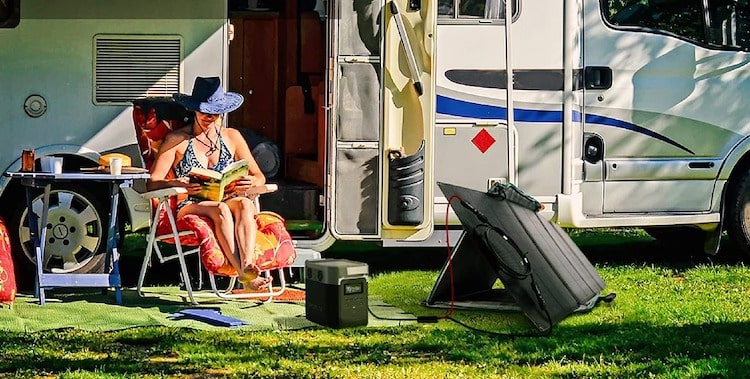
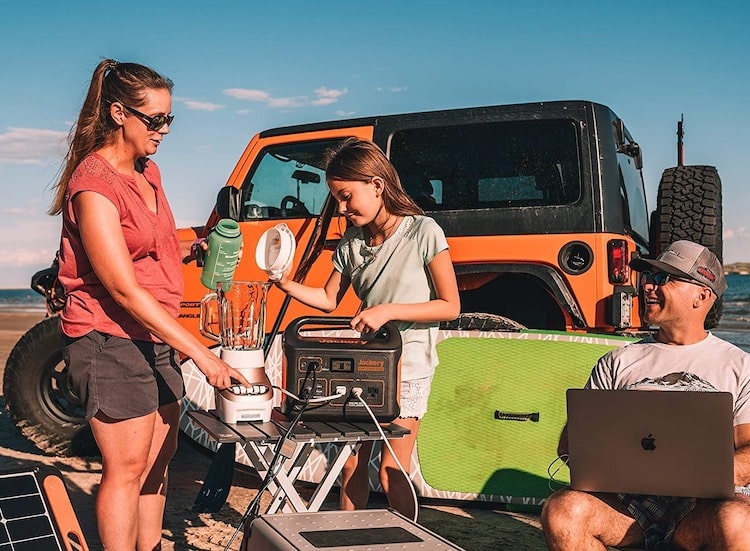
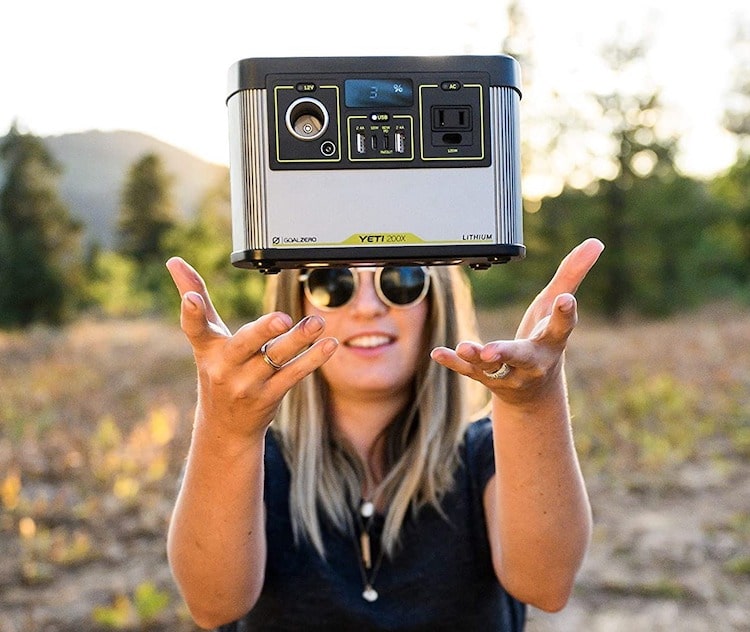
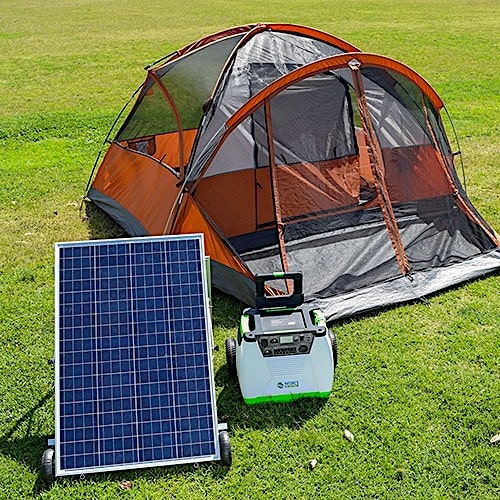
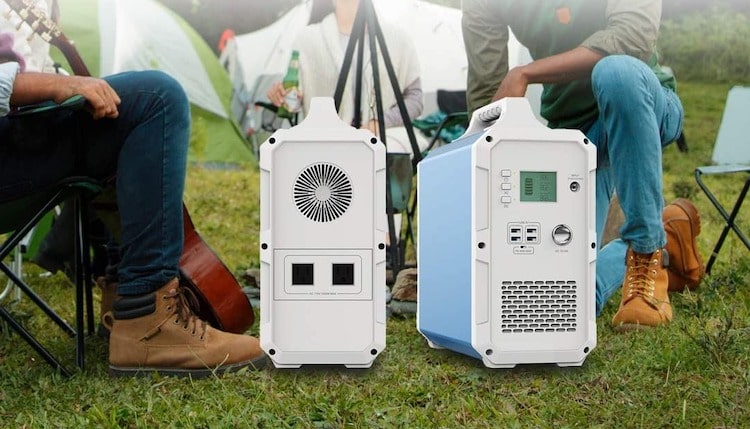

great article RV newbie here,looking to purchase the Eco Flow Delta Pro for 30 AMP shore power any insight on how long I can run a 5th wheel for how many days? Thanks looking forward to getting out on my land! And I need that Delta pro to survive this winter living FT in my RV thanks!